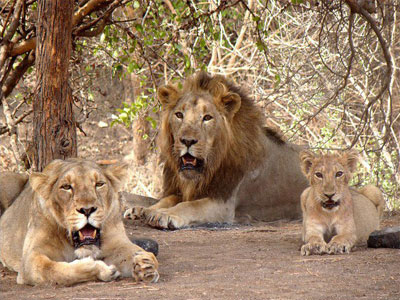
Bandhavgarh National Park is one of the famous national parks in
India which is located in the Umaria in the district of Madhya Pradesh.
Bandhavgarh was declared a national park in 1968, with an region of
105 km. The buffer is spread over the forest divisions of Umaria
and Katni and totals about 820 km. The park derives its name from the
most prominent hillock of the area, which was said to be given by
Hindu Lord Rama to his brother Lakshmana to keep a watch on Lanka.
Hence the name Bandhavgarh.This park has a major biodiversity. The density of the tiger
population at Bandhavgarh is one of the highest known in India.
The park has a large breeding population of leopards,
and lots of species of deer. Maharaja Martand Singh of Rewa
captured the first white tiger in this region in 1951.
This white tiger, Mohan, is now stuffed and on display in the palace
of the Maharajas of Rewa. Historically villagers and their cattle
have been a threat to the tiger. Rising mining activities around the
park are putting the tigers in danger situation.
Bandhavgarh has one of the lots of of Bengal tigers known in
the world, and is home to some populured named tigers which are vast
in size and are looks in beautiful. Charger, an animal so named because of
his habit of charging at elephants and tourists was the first healthy male known to be living in Bandhavgarh since the 1990s. A female known as Sita, who once showed on the cover of National Geographic and is known as the second
most photographed tiger in the world, was also to be found in
Bandhavgarh for many years. Almost all the tigers of Bandhavgarh
today are descendants of Sita and Charger. Their daughter Mohini,
son Langru and B2 also managed their tradition for frequent
sighting and moving close to tourist jeeps.
The three primary zones of the national park are Tala, Khitauli and
Magdhi. Tala is the wealthiest zone in terms of biodiversity, mainly
tigers. Together, these four ranges comprise the 'Core' of the
Bandhavgarh Tiger Reserve constituting a total area of 716 km.
The buffer zone is spread over the forest divisions of Umaria
and Katni and totals another 820 km. The legal status as a national
park dates back to 1968, but was limited only to the present Tala
range for a considerable length of time. In 1993 the present scheme
of things was put in place.
According to biogeographic classification, the area lies in Zone
6A- Deccan Peninsula, Central Highlands (Rodgers, Panwar & Mathur,
2000). The classification of Champion & Seth lists the area under
Northern India Moist Deciduous Forests. The vegetation is chiefly
of Sal forest in the valleys and on the lower slopes, gradually
changing to mixed deciduous forest on the hills and in the hotter
drier areas of the park in the south and west.

Asian Paradise Flycatcher

Fire Tailed Myzornis

Himalayan Monal

Indian Peafowl

Asian Paradise Flycatcher

Fire Tailed Myzornis

Himalayan Monal

Indian Peafowl

Indian Pitta

Mrs. Gould’s Sunbird

Oriental Dwarf Kingfisher

Red Headed Trogon

Sarus Crane

Satyr Tragopan

Storm petrels